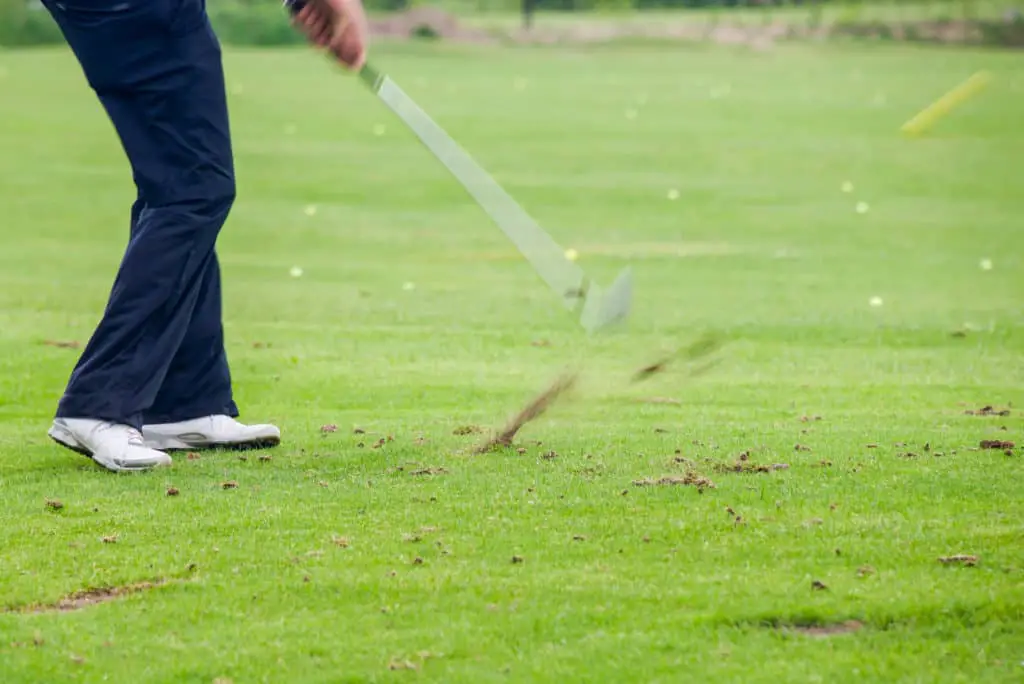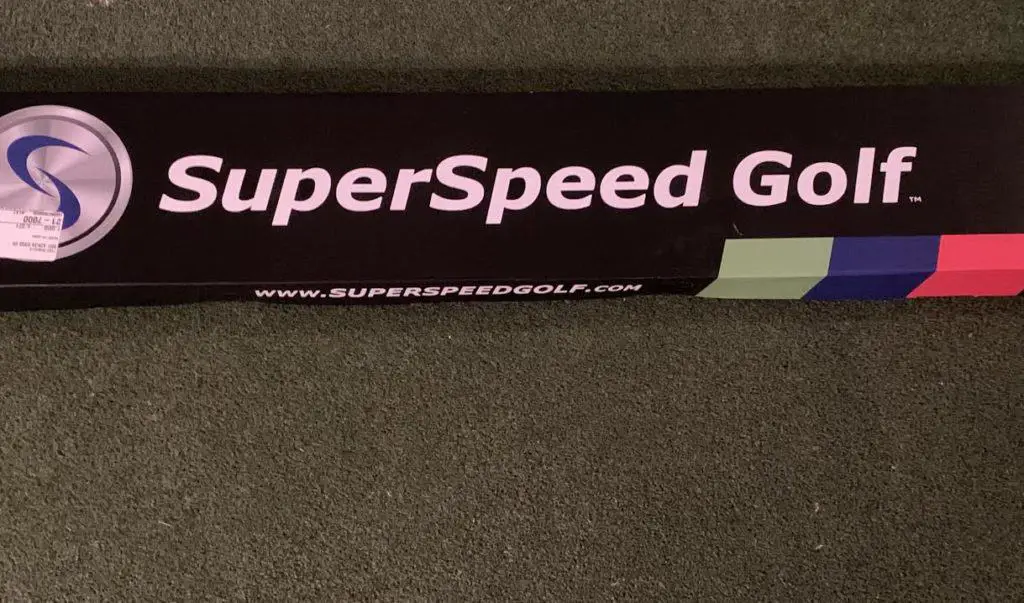Golf can be a mind boggling game.
One day you might hit great shots.
But the next day you hit thin or fat shot, or shots to the left or right. You can’t seem to find any consistency in your game.
The good news is that we have some tips to help you get better and to eliminate those thin and fat shots in golf.
Why Do I Hit Thin Golf Shots?
Thin golf shots are primarily a result of poor low point control. The golfer frequently fails to get the pressure or weight far enough into his or her front foot, resulting in a timing based swing that doesn’t match up just right.
The golfer might be too far back and releases the club to avoid the fat shot and instead hits a thin shot. Most fat and thin shots are the result of the same swing issue (bad low point control). The solution is the same for both and we have a great drill below.
The best golfers are able to control their low point by controlling where the pressure and/or weight is in their golf swing. Before we dive into the drill you can use, let’s first talk about the three keys to consistency.
- Low Point Control: Golfers must first learn to control their low point, which will greatly improve the solid contact in their golf swing. They will then strike the ball solid and eliminate the fat and thin shots that can be devastating to a round of golf.
- Start Line and Predictable Curve: Golfers also need to develop the ability to start the ball on their intended start line and have a predictable curve. Creating a consistent shot pattern, when paired with great low point control, often leads to a great improvement in the golf score.
- Speed: The golfer must swing fast enough to produce enoug distance to play the course. Recent advancements in the game of golf have allowed people of all ages to see an increase of 3-7% through various speed training protocols (see below for more details)

How To Fix The Thin Shots?
It is one thing to understand the issue, it is another thing to have a solution built upon a drill that a golfer can utilize to actually improve his or her swing. We believe in using drills to help train the swing to have a swing motion that works.
Recommended Drill: Low Point Control
- Take some yard paint and paint a 1-2 yard long line.
- Setup with 55% of your weight on your front side.
- Try to hit the target side of the line and see how many times out of 10 you can do this successfully!
- Repeat this drill every day for a month, tracking your progress and your ability to to this successfully in trials of ten.
- You may need to start with half swing and progress to full swings.
If you are struggling, put more weight forward and work on keeping your head still to help control the low point in the swing.
I would recommend using this drill as often as possible until you are able to stroke the ball with a 99% success rate. Some of the weakest golfers might only hit a ball solid 40-50% of the time. They will often strike one solidw, which keeps them coming back.
Keep using this drill and learn to control the very first fundamental in the golf swing: low point control!

Next Steps: Assess Your Game
After using this drill, head to the course and keep a tally of how many shots you hit solid vs the number of shots attempted. Use this drill between rounds of golf and measure if you are making progress in the next 5-10 rounds of golf. Keep working and your scorecard of solid shots should improve.
Once you feel you have eliminated your thin shots or fat shots in golf, you can consider the next two drills or training protocols.
The Drill: Stock Shot Drill
- At the driving range, set up an alignment stick about 6-8 yards in front of you, straight down your target line.
- If you have a second alignment stick, set the stick 3-4 feet right of the first stick (for a draw) or left of the first stick (for a fade).
- Complete your initial assessment see how many times out of 10 you can start the ball to the right or left of your target. Pick one side and measure your game at this point.
- The goal is to eventually get 7 out of 10 shots to start to the correct side and draw back towards the target.
Here is the drill being explained by Kyle Morris:
The combination of solid contact (low point control drill) and the ability to hit a stock shot (consistent curve) is the first step in truly becoming a solid golfer who can manage his or her game.
Final Thoughts: Train For Speed!
Could you imagine a controlled golf swing with plenty of speed that puts you in the top 3-5% of golfers in distance with your driver? The good news is that additional swing speed is attainable and worth practicing for!
The game of golf has evolved to where speed is important in the game of golf. The faster your swing, the further the ball flies and the more shorter irons or wedges you have into a green.
Training for speed is a great idea and one worth exploring!
My 50% swing example above can be a great swing because I have enough in my swing to still hit the ball far enough with the feel of a bunt swing.
If you are going to train for speed, I would highly recommend the SuperSpeed Training System.
Gone are the days of simply being content with the distance you currently hit your golf ball. Many older golfers have proven over the past several years that an increase in swing speed is possible.
There are training systems to help you get your game to the next level and distance is arguably the fastest way to make this happen!
My number one recommendation is to check out SuperSpeed Golf and their protocols to help you find a safe way to increase your swing speed.
I spent many years wondering how I can increase my swing speed. When I was playing junior golf, we weren’t fortunate enough to have some of the training aids and knowledge that is now available. Smart people have studied the golf swing and have created training aids and protocols to help all golfers increase their distance!
At around the same time, the statistics from the PGA Tour have become more clear and the importance of speed is acknowledged by many to be a key to being the best on the PGA Tour.
Within the past several years, there have been several products hit the market to make speed gains possible. While many people for many years waited for the latest driver to come out to gain an additional 5-10 yards, you can now do this even with your current clubs.
Did you know that with the SuperSpeed Training System you can gain 5-8% increase in swing speed as early as the first training session? This would allow you to gain somewhere between 10 and 30 yards depending on your current swing speed.
The SuperSpeed Training System is based on three different swing speed sticks all weighing at different weights. There is a green club that is 10% lighter than the average driver, the blue club which is 5% lighter and the red club which is actually 5% heavier!
Following their prescribed protocols the golfer completes the training every other day. The total time to complete most of their protocols is between 10-15 minutes. Most people can find the time to make this happen. The golfer will also need a swing radar to measure their progress.
The science behind the SuperSpeed Training System is based on overspeed training. Overspeed training has been around for several decades now and has been used by olympic athletics in the sport of Track and Field.
The science behind this overspeed training is based on the premise that your brain will only allow your body to move as fast as it feels it can stop safely! So, you get to work and swing the clubs as fast as possible, retraining your brain to allow you to swing your driver faster.
For more permanent results, the golfer should continue these training protocols for several months. The initial 5-8% is great and can become more permanent with the right length of training. The golfer can expect to continue to break down barriers every several months at a 1-2% increase.
My own experience has been an increase of 7-10 miles per hour on average from between 98-101 all the way up to 106-109. My goal is to hit the PGA Tour average of 113 mph in the coming months. I will continue to train every other day and watch in amazement as I am hitting drivers longer now than ever before!
Phil Mickelson (a senior golfer now) has been known to increase his swing speed in the past year or so and is close to 120 miles per hour in his swing speed. There are potential results for golfers of all ability levels and age!
Check the current price on SuperSpeed Golf System, here!
| Original Swing Speed | After 4-6 Weeks | New Carry Distance | Total Distance |
| 95 | 102 | 245 | 265 |
| 100 | 108 | 259 | 279 |
| 105 | 113 | 271 | 291 |
| 110 | 118 | 283 | 303 |

My Secret To Golf Improvement
Let’s face it, in order to get really good at golf, we must practice frequently. About three years ago, I made the leap and invested in a golf simulator build for my garage. I went with a SkyTrak Launch Monitor and the TGC software and can now play over 100,000 courses including Augusta, Pebble Beach, Bethpage Black, Whistling Straits. St. Andrews and many other of the top 100 courses in the world.
This golf simulator setup, which is more affordable that you might imagine, has been a game changer. I can now play golf everyday of the year regardless of rain, snow, cold weather or time of day. I can practice or play rounds of golf. I can stand in the 11th fairway at Augusta and with the auto-rewind feature I am able to practice my approach shots from various differences.
It is worth checking out through Rain or Shine Golf as they offer some incredible packages along with financing offers that are difficult to beat.
Some direct links to Rain or Shine Golf for pricing and financing:
Take Action – What You Can Do Today to Get Better
What does this mean for you? I believe in the following recipe to get better:
1 – Improve your motion in the golf swing by identifying a golf instructor. Here are some options:
Here is a list of golf instructors that we have reviewed:
2 – Train to swing faster and improve your swing speed. Here are some options:
Looking to gain more Speed and Distance in your swing. Two Options:
3 – Understand course strategy and work to break through your next barrier. Here is a series on breaking through:
We have provided guides on how to break 100, 90, 80 and 70. Check out more below, if interested.
4 – Practice Frequently
Did you know that I build a golf simulator in my garage and have played over 500 rounds of golf on my SkyTrak system? It has been a game changer and one worth checking out. Here are some of my other posts on golf simulators frequently asked questions:
- Is a Golf Simulator Worth It?
- How to Build a Golf Simulator?
- What is the Best Golf Simulator?
- Golf Simulator Accessories?
- How to Build a Golf Simulator for under $7000
- Top 11 Reasons to Buy a SkyTrak
- How to Build a Golf Simulator for Under $1000
- Why Build A Golf Simulator?
- What Space is Needed?
- Can A Golf Simulator Improve My Game?
- How Much Does A Golf Simulator Cost?
- Don’t Forget to Check out our 15 best golf swings of all time.
